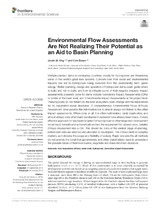| dc.contributor.author | King, Jackie M. | |
| dc.contributor.author | Brown, Cate | |
| dc.date.accessioned | 2018-11-19T08:40:21Z | |
| dc.date.available | 2018-11-19T08:40:21Z | |
| dc.date.issued | 2018 | |
| dc.identifier.citation | King, J.M. & Brown, C. (2018). Environmental flow assessments are not realizing their potential as an aid to basin planning. Frontiers in Environmental Science, 6: 113. | en_US |
| dc.identifier.issn | 2296-665X | |
| dc.identifier.uri | http://dx.doi.org/10.3389/fenvs.2018.00113 | |
| dc.identifier.uri | http://hdl.handle.net/10566/4208 | |
| dc.description.abstract | Multiple planned dams in developing countries, mostly for hydropower, are threatening
some of the world’s great river systems. Concern over their social and environmental
impacts has led to hydropower being excluded from the sustainability term ‘green
energy.’ Better planning, design and operation of hydropower dams could guide where
to build and not to build, and how to mitigate some of their negative impacts. Impact
assessments presently done for dams include Cumulative Impact Assessments (CIAs)
or similar at the basin level, and Environmental Impact Assessments at the project level.
These typically do not detail how the river ecosystem could change and the implications
for its dependent social structures. A comprehensive Environmental Flows (EFlows)
Assessment does provide this information but is almost always not linked to the other
impact assessments. When done at all, it is often rudimentary; rarely basin-wide; and
almost always done after major development decisions have already been made. A more
effective approach for any basin targeted for hydropower or other large damdevelopment
would be to formally and automatically embed the requirement for a basin-wide, detailed
EFlows Assessment into a CIA. This should be done at the earliest stage of planning,
before dam sites are selected and allocated to developers. The EFlows method adopted
matters, as it dictates the scope and flexibility of a study. Rapid one-size-fits-all methods
do not provide the detail that governments and other stakeholders need to understand
the possible future of their river basins, negotiate and make informed decisions. | en_US |
| dc.language.iso | en | en_US |
| dc.publisher | Frontiers Media | en_US |
| dc.rights | Copyright © 2018 King and Brown. This is an open-access article distributed
under the terms of the Creative Commons Attribution License (CC BY). The use,
distribution or reproduction in other forums is permitted, provided the original
author(s) and the copyright owner(s) are credited and that the original publication
in this journal is cited, in accordance with accepted academic practice. No use,
distribution or reproduction is permitted which does not comply with these terms. | |
| dc.subject | River degradation | en_US |
| dc.subject | EFlows | en_US |
| dc.subject | Basin-wide | en_US |
| dc.subject | Hydropower | en_US |
| dc.subject | Cumulative Impact Assessments | en_US |
| dc.title | Environmental flow assessments are not realizing their potential as an aid to basin planning | en_US |
| dc.type | Article | en_US |
| dc.privacy.showsubmitter | FALSE | |
| dc.status.ispeerreviewed | TRUE | |

